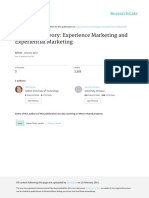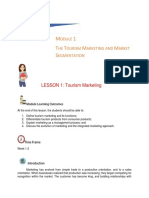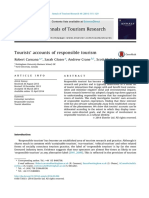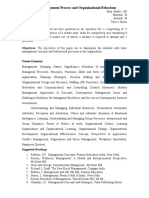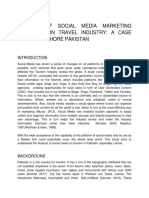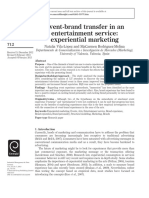Customer Loyalty and The Impacts of Service Quality: The Case of Five Star Hotels in Jordan
Customer Loyalty and The Impacts of Service Quality: The Case of Five Star Hotels in Jordan
Uploaded by
Bella AndikaCopyright:
Available Formats
Customer Loyalty and The Impacts of Service Quality: The Case of Five Star Hotels in Jordan
Customer Loyalty and The Impacts of Service Quality: The Case of Five Star Hotels in Jordan
Uploaded by
Bella AndikaOriginal Description:
Original Title
Copyright
Available Formats
Share this document
Did you find this document useful?
Is this content inappropriate?
Copyright:
Available Formats
Customer Loyalty and The Impacts of Service Quality: The Case of Five Star Hotels in Jordan
Customer Loyalty and The Impacts of Service Quality: The Case of Five Star Hotels in Jordan
Uploaded by
Bella AndikaCopyright:
Available Formats
International Journal of Human and Social Sciences 5:13 2010
Customer Loyalty and the Impacts of
Service Quality:
The Case of Five Star Hotels in Jordan
Al-Rousan, M. Ramzi, Badaruddin Mohamed
United Nations World Tourism Organization [4]. The above
statistics have illustrated that the tourism industry has joined
the ranks of agriculture and mining in terms of industry size.
Together with customers loyalty, quality is an equally
important factor and may lead to the success of the tourism
business. Kandampully [5] has emphasized that quality will
steer tourism firms to successfully encounter the competitive
challenges of the future.
For Parasuraman et al. [6], service quality is both the
significant differentiator and the most aggressive weapon
possessed by many leading service organization. It has been
discovered that leading service organizations endeavor to
sustain a superior quality of service over their competitors in an
effort to acquire and retain customer loyalty [7]. This is based
on the concept where the service organizations ability to
expand and maintain a large and loyal customer base is
essential for their long term success in a market. In the face of
such critical importance of customer loyalty being vital for
business survival [8], it is rather strange that the relationships
between service quality and customer loyalty are not equally
well-developed [9]; [10].
This paper is a part of an extensive study conducted on
tourism service quality focusing on the importance of the
relationship between tourism service quality dimensions and
customer loyalty at five star hotels in Jordan.
AbstractIn the present Jordan hotels scenario, service quality is
a vital competitive policy to keep customer support and build great
base. Hotels are trying to win customer loyalty by providing enhanced
quality services. This paper attempts to examine the impact of tourism
service quality dimension in the Jordanian five star hotels. A total of
322 surveys were administrated to tourists who were staying at three
branches Marriott hotel in Jordan. The results show that dimensions of
service quality such as empathy, reliability, responsiveness and
tangibility significantly predict customer loyalty. Specifically, among
the dimension of tourism service quality, the most significant predictor
of customer loyalty is tangibility. This paper implies that five star
hotels in Jordan should also come forward and try their best to present
better tourism service quality to win back their customers loyalty.
KeywordsTourism, Service Quality, Loyalty, Five Star hotels,
Jordan.
I. INTRODUCTION
HE hotel industry, in particular, and all businesses whose
service depend on building long term relationship need to
concentrate on maintaining customers loyalty. In this respect,
loyalty is greatly influenced by service quality. As such, hotels
often invest in managing their relationships with customers and
maintaining quality to ensure that customers whose loyalty is in
the short term will continue to be loyal in the long term. The
growth in tourism is well anticipated as evident in the
researches and analyses conducted by experts and relevant
organizations in this industry. Burns and Holden [1] were
among the early proponents of the idea where tourism is
becoming one of the largest global export industries.
Subsequently, Weaver and Oppermann [2] have observed that
tourism has developed from a marginal local activity to a global
economic giant representing about 6 per cent of the global
economy and creating approximately 200 million jobs
worldwide during the later decades of the twentieth century.
With the rapid growth in the tourism industry, it is projected
that global travel and tourism would generate US$7.0 trillion in
economic activity and 260 million jobs by 2011[3]. The robust
growth is also attested to by the analyses conducted by the
II.
CUSTOMER LOYALTY AND TOURISM SERVICE
QUALITY
As it is, feelings and attitudes experienced by customers via
the service provided by hotels form the perception of service
quality. Based on their personal perceptions of the services,
customers generally form their experiences [11]. Many studies
have investigated the relationship between service quality and
customer loyalty [12]; [13], on the complaints received from
customers [14]. Here a complaint is seen in the light of the
customers request for better service and possible continued
usage of the product in the near future.
In addition, customer loyalty is seen as one of the major
facilitators of service quality that emerged from the literature.
Customer loyalty happens when there is repeated purchasing by
the same customers and their willingness to recommend the
product to other customers without any outright benefits [15],
and eventually the repeated usages would generate positive and
quantifiable financial results [16].
Among the economic benefits of customer loyalty are
improvements in retention and increase in the share of a
Ramzi AL Rousan is with School of Housing ,Building and Planning ,
Universiti SainsMalaysia, 11800 USM, Penang, Malaysia (corresponding
author to provide phone: 0060-173-493-107; e-mail:
manzomh45@yahoo.com).
Badaruddin Mohamed is with School of Housing ,Building and Planning ,
Universiti SainsMalaysia, 11800 USM, Penang, Malaysia (phone: 604-653
3108 ext: 3988., Fax: 604-656 6466.,e-mail: bada@usm.my).
886
International Journal of Human and Social Sciences 5:13 2010
company. Customer loyalty means a customer would return or
continue to use the same product or other products of the same
organization, make business referrals, and intentionally or even
unintentionally providing strong word-of-mouth references and
publicity [17]. Loyal customers are those who are not easily
swayed by price inducement from competitors, and they
usually purchase more than those less loyal customers [18]. On
the other hand, service providers must avoid being complacent
as retained customers may not always be the satisfied ones and
similarly not all satisfied customers may always be retained.
There are many factors for such manner of loyal customers.
Some customers may remain loyal due to high switching
barriers or the lack of real substitutes, while others continue to
be loyal because they are satisfied with the services provided.
Past researches have pointed out that perceived service quality
has an impact on customer loyalty. In their study on retail trade,
Wong and Sohal [19] discovered a positive relationship
between service quality and customer loyalty. Other
researchers had found a positive relationship between service
quality and loyalty in the banking sector [12]; [20]. All the
researchers have unilaterally agreed that service quality is
related to behavioral outcomes, especially in the form of
word-of-mouth, complaint, recommendation and switching.
The methods to measure how service quality helps practitioners
effectively manage the delivery of quality service have become
the focus of other researchers [21]; [6]; [22]; [23]; [24]; [25].
Among the various measurement models/frameworks on
service quality in the existing literature, SERVQUAL and
SERVPERF are becoming quite popular.
Parasuraman et al. [6] developed SERVQUAL in their study,
which includes tangibles, responsiveness, assurance-empathy
and reliability. Subsequently, the SERVQUAL framework has
guided numerous studies in the service sector focusing on
various organizations, like hotels [26], tourism [27], dental
services [28], hospitals [29]; [30], However, critics have
questioned and found faults with its conceptual appropriateness
[31], low reliability [32], problems with discriminate validity
[33] and also unstable dimensionality [22]; [34]; [35]; [36];
[37]; [14]. As a result, Cronin and Taylor [24] developed
SERVPERF, a modified and improved version of
SERVQUAL, which determines service quality by only
measuring performance. Based on the literature review in the
field of service quality, this study aims to address certain gaps
that have been identified. For a start, there is a scarcity of
empirical research investigating the association of all the
variables of service quality and customer loyalty in the
Jordanian hotel industry. Apart from this, the impact on the
hotels attitudes to provide better quality services in the face of
economic changes need to be addressed as well.
The main objective of this study is to examine the strength of
association between the variables of service quality and
customer loyalty in five-star hotels in Jordan.
responsiveness, which is how an individual customers
requests are handled beyond traditional service measure [39].
Service quality measures how well the service delivered could
match customers expectations while delivery service quality
refers to meeting and satisfying customers expectation
consistently and positively. Therefore, this research tests
whether there is a positive relationship between service quality
and customer loyalty. Therefore, the hypotheses of this study
can be formulated as follow:
Hypotheses1: Tourism service quality positively affects
customer loyalty in five star hotels in Jordan
H1.a: There is a significant positive correlation between
tangibility and customer loyalty in five star hotels in Jordan.
H1b: There is a significant positive correlation between
reliability and customer loyalty in five star hotels in Jordan.
H1c: There is a significant positive correlation between
responsiveness and customer loyalty in five star hotels in
Jordan.
H1d: There is a significant positive correlation between
assurance and customer loyalty in five star hotels in Jordan.
H1e: There is a significant positive correlation between
empathy and customer loyalty in five star hotels in Jordan.
IV. METHODOLOGY
A self-administered questionnaire, an adapted version of
SERVQUAL scale, was used in this paper to measure the
perceived tourism service quality of the hotel guests. There are
various models used by researchers to assess service quality,
i.e. SERVQUAL [40], SERVPERF [24] and Non-Difference
[41]. This study used the SERVQUAL model to measure the
study dimensions due to its high reliability and validity in
previous studies. Our research instrument design is based on
the five dimensions of service quality and the 23 service items
of the SERVQUAL model. Some modifications were made to
the items in order to suit the context of hotels. The
questionnaire was divided into three parts. The first part of the
questionnaire contained questions relating to
socio-demographic data about the respondents. The second part
was designed to measure the respondents perceptions
regarding quality of services offered by the hotel. Meanwhile,
the third part of the questionnaire assessed the respondents
perceptions regarding loyalty on the same five-point scale.
Seven customer loyalty items were adapted from Zeithaml et
al., [7] and Ndubisi [42]. The researchers introduced the tool of
measurement in such a way that it briefly illustrated the topic of
the study and procedures of response. The measurement grades
were placed according to the five-point Likert scale [43]. The
scales were ordered regressively as follows: Strongly agree (5),
Agree (4), Neutral (3), Disagree (2), and strongly disagree (1).
The study was conducted in three branches of the Marriot
Hotel chain situated in three cities in Jordan for three months in
the summer of 2008. The target population selected for this
study during the data collection period comprised tourists who
stayed in all three branches of the Marriot Hotel. A
convenience sampling approach [44] was employed, in which
322 questionnaires were distributed to the guests who agreed to
participate in the survey. The guests completed the
questionnaires in the presence of the researchers. The
III. HYPOTHESIS
In the tourism sector, service quality has two aspects [38] in
the form of basic service quality and responsiveness. The first
is basic service quality, and it involves cycle time, on-time
delivery, and inventory availability. The second aspect is
887
International Journal of Human and Social Sciences 5:13 2010
completed questionnaires were then collected by the
researchers immediately.
The Statistical Package for the Social Sciences (SPSS)
version 16.0 was used to analyze the data. Descriptive statistics
analysis was used to measure customers perception scores. To
explore the dimensionality of the 23-item scale, a factor
analysis was performed. Validity and reliability of the adapted
scale were established. Validity tests determine how well an
instrument measures a particular concept. Reliability of a scale,
on the other hand, indicates the stability and consistency with
which the instrument measures the concept and helps assess the
goodness of a measure [45]. A reliability analysis was
employed to have an idea on the internal consistency among the
items and the convergent validity of the overall scale.
Within-scale factor analyses were used to ensure that all
indicators in the scale measured the same construct. This
process is known as construct validity [46]. To test the internal
consistency of each factor, a reliability analysis was conducted.
Based on the new factors derived from the factor analysis, a
multiple regression analysis was used to identify the relative
importance of the factors in predicting customer loyalty with
the service quality provided by the Marriot hotels in Jordan.
V.
Status
Education
Occupation
Annual
Income
RESULT AND ANALYSIS
The analyses of the collected data were carried out through
various statistical techniques such as factor analysis, validity
analysis and multiple regressions. The data were compiled and
analyzed using the Statistical Package for the Social Science
(SPSS 16) for Windows computer software.
Table I shows the demographics of the respondents. As can
be seen from Table I, the gender distribution was 56.5% female
and 43.5% male. The highest proportion of the respondents
(18.3%) fell into >63 year age group, followed by the 27-32
year age group (14.9%). The majority of respondents were
married (51.9%). The question on the educational level of
customers showed that 42.5% of the respondents had a
university degree, followed by diploma (20.2%), postgraduate
(12.1), and others (Professional Editor, Specialized Market
Research). A variety of occupations were reported by the
respondents. The highest frequencies were private sector
(45.5%), followed by government (18.9%). As for annual
income, the highest rate was $21000-$30000 (32.0%), while
the lowest rate was $61000-$70000 (2.5%).
Figure 1 show that the majority of respondents came from
Europe (70%) followed by America (19%), while the number
of tourists from Australia (6%) and Asia (5%).
Category
Male
Female
Age
56.5
< 20 years old
11
21-26 years old
28
3.4
8.7
27-32 years old
48
14.9
33-38 years old
43
13.4
39-44 years old
33
10.2
8.7
57-62 years old
31
9.6
63> years old
59
18.3
Single
106
32.9
Married
167
51.9
Divorced
22
6.8
Widowed
27
8.4
Primary School
25
7.8
Secondary School
24
7.5
Diploma College
65
20.2
University Degree
137
42.5
Postgraduate Degree
39
12.1
Others
32
9.9
Government
61
18.9
Own Business
49
15.2
Private Sector
145
45.0
Retired
49
15.2
Others
18
5.6
37
11.5
$21000-$30000
103
32.0
$31000-$40000
86
26.7
$41000-$50000
35
10.9
$51000-$60000
38
11.8
$61000-$70000
2.5
>$70000
13
4.0
<$20000
Factor analysis was used to reduce the items to several
factors. Some items sometimes represent the same idea, thus
these can be omitted if they are redundant or unnecessary. The
number of participants in the present research is 322.
According to Hair et al. [47], if the number of samples in the
factor analysis is 100 or larger, factor loadings in the range of
.30 to .40 are considered to meet the minimal level for
interpretation of structure. Loading of .50 or greater are
considered practically significant, and loadings exceeding .70
are considered indicative of well-defined structure and are the
goal of any factor analysis. The adequacy of the sample size
43.5
182
12.7
28
VI. FACTOR ANALYSIS
Frequency Percent
140
41
51-56 years old
Fig. 1 Country of Origin of the Respondents
TABLE I
PROFILE OF THE RESPONDENTS (N=322)
Gender
45-50 years old
888
International Journal of Human and Social Sciences 5:13 2010
was confirmed using both the Kaiser-Meyer Olkin (KMO) test
sampling adequacy and Barletts Test of Sphericity. In fact,
KMO for tourism service quality (0.86), customer satisfaction
(0.89) and customer loyalty (0.89) exceeded satisfactory
values. The retention decision of each item was based on factor
loadings which were greater than or equal to 0.50;
cross-loading with the other factors were generally smaller than
0.35[48].
The brochures and pamphlets are Q5
visually presented
The hotel is clean
Q6
The results of the factor analysis concerning tourism service
quality shows that all of the items is found to have a
five-dimensional construct with 23 items. The results indicate
that the five factor solutions with Eigenvalues were greater than
1.0, and the total variance explained was 72.91% of the total
variance. The KMO measurement of sampling adequacy was
.86, indicating sufficient inter-correlations. Meanwhile, the
Barlett Test of Sphericity was significant (Chi square= 6.360,
p<.001). By identifying whether or not the correlation matrix is
an identity matrix, one can be certain if the variables are
unrelated. The chi-Square significant level was less than .01.
Therefore, a value higher than about .10 or so may indicate that
data are not suitable for factor analysis as mentioned in Table II
and Table III.
The front-desk employee Q7
accurately verified the reservation
requests
.838 .139 .261 .177 .039
The time it took to check in or Q8
check out is not too long
.701 .197 .060 .139 .273
The reservation system (e.g., Q9
telephone or internet reservation)
is easy to use
.610 .181 .108 .145 .260
Transport facilities are available
Q10 .885 .096 .232 .140 .069
The employees provide error-free Q11
records
The employees are courteous
Q12 .246 .192 .289 .601 .183
The employees gave us special Q13
attention
.190 .150 .213 .813 .285
The employees adapted services to Q14
our needs
.163 .238 .088 .830 .182
The staff are willing to help guests Q15 .146 .160 .132 .889 .262
Assurance (X4)
The staff in the hotel are polite
Q16 .103 .271 .118 .249 .670
The staff imparted confidence to Q17
the guests
Chi-Square
KMO
Empathy (X5)
.862
The employees quickly apologized Q20
when service mistakes are made
.238 .085 .873 .182 .200
The employees listened carefully Q21
when you complain
.216 .116 .906 .187 .165
The employees
customers by name
.212 .122 .864 .184 .133
The KMO measures the sampling adequacy which should be
greater than 0.5 for a satisfactory factor analysis to proceed.
Looking at the Table (IV), the KMO measure is .904. From the
same table, we can see that the Bartlett's test of sphericity is
significant (Chi-Square = 1.4923; p<0.001).
Table (V) explain a factor loading is the correlation between
a variable. Factor loading came from a factor that has been
extracted from the data set. The loading for customer loyalty
was ranging from .783 to .858. At the same time, the
Eigenvalues is 4.76 and the total variance is 68%.
Employees understand
customer's requirements
X3
X4
Tangibility (X1)
Furniture in this hotel is modern Q1
and comfortable
-.010 .843 .096 .123 .128
The interior and exterior Q2
decoration in this hotel is quite
appealing
.142 .618 .258 .331 -.091
have
The hotel facilities are up-to-date
neat Q3
Q4
the Q23
.190 .204 .709 .078 .314
9.570 2.367 1.963 1.589 1.282
Total Variance (72.91%)
16.52 15.49 15.26 13.65 11.96
7
8
8
2
8
TABLE IV
Component
X5
the Q22
Eigenvalues
KMO
Chi-Square
.904
1.4923
NOTE: ***P<0.001
X1
called
KMO AND BARTLETT'S TEST FOR CUSTOMER LOYALTY
TABLE III
FACTOR ANALYSIS FOR TOURISM SERVICE QUALITY
The employees
appearances
.305 -.011 .272 .165 .677
253***
FACTOR ANALYSIS OF CUSTOMER LOYALTY
Code X2
Q18 .163 .201 .183 .208 .797
df
Note: ***p<0.001
VIII.
.063 .220 .268 .285 .685
The staff had sufficient support Q19
from the hotel to do their jobs
TABLE II
KMO AND BARTLETT'S TEST FOR TOURISM SERVICE QUALITY
6.3603
.860 .175 .270 .139 .062
Responsiveness (X3)
The staff are friendly
.862
.043 .872 .088 .183 .102
Reliability (X2)
VII. FACTOR ANALYSIS FOR TOURISM SERVICE
QUALITY
KMO
.258 .607 .192 .201 .120
.267 .627 .029 .002 .236
.299 .662 .011 .087 .291
889
df
21***
International Journal of Human and Social Sciences 5:13 2010
TABLE V
FACTOR LOADING FOR CUSTOMER LOYALTY
Customer Loyalty (Y2)
Code Y2
I would recommend this hotel to other people
Q31 .790
I would like to stay in this hotel next time
Q32 .843
TABLE VII
REGRESSION RESULTS ON TOURISM SERVICE QUALITY AND
CUSTOMER LOYALTY
Service Quality
t-value Standardized Coefficients Beta
Tangibility
9.062
.413***
I would like repurchase many services in this hotel Q33 .783
Reliability
3.437
.162**
I would encourage friends and relatives to visit this Q34
hotel
Responsiveness
1.991
.099*
Assurance
1.431
.072
Empathy
4.605
.219***
I consider the performance in this hotel strong
.853
Q35 .839
I would consider this hotel as my first choice when I Q36
need hotel service
I intend to continue using this hotel
Q37 .805
Eigenvalues
.858
4.762
Total Variance (percent)
68.028
Note: Underline loadings indicate the inclusion of that item in the factor
80.942***
.564
Adjusted R
.557
R Change
.564
F Change
80.942***
Note: *p<0.05; **p<0.01; ***p<0.001
IX. VALIDITY ANALYSIS
One of the major criticisms SERVQUAL has received from
researchers is on the dimensionality of service quality. The
most serious criticisms concern the number of dimensions, and
their stability from one context to another [49]. When
SERVQUAL is employed in modified forms for different
service fields, researchers identified varying numbers and
contents of dimensions according to the service sector under
investigation [49]. Parallel to these claims, numerous studies
have been conducted on service quality in the hotel industry
[34]; [50]; [51]; [52]. These studies have produced several
contributions to help gain an understanding of the dimensional
structure of service quality of hotels.
This study was conducted in the five star hotels in Jordan and
identified five service quality dimensions tourists use to
evaluate service quality in these hotels. The findings confirmed
the five-dimensional structure of SERVQUAL, but some of the
dimensions found along with its components differed from that
of SERVQUAL. These findings support the claim that the
number of service quality dimensions is dependent on the
particular service being offered; in addition, different measures
should be developed for different service contexts [23]; [22].
The studies conducted in the hotel industry produced different
outcomes with regards the hierarchy of dimensions in
contributing to an overall assessment of service quality. Akan
[26] reported that the most important dimension is the
courtesy and competence of hotel personnel, while Mei et al.,
[52] reported that employees comprise the most important
dimension. On the other hand, Saleh and Ryan [34] reported
that most important dimension was conviviality, while
Knutson et al. [53] found it to be reliability. Ekinci et al.
[54] stated in their study that intangibles were the most
important dimensions influencing the perception of quality in
the hotel sector. In this study, it was found that assurance is
the most important factor in predicting tourists service quality
evaluation. This appeared to be different from that in
Parasuraman et al.s [6] study, wherein reliability is defined
as the best predictor. This finding suggests that for the guests of
hotels, the purpose of their stay may be an important
determining element when evaluating the quality of hotels.
Table (VI) presents the validity analysis for this research was
carried out using Cronbachs Alpha. The validity for the
potential variables were found to be 0.85 for tangibility, 0.90
for reliability, 0.90 for responsiveness, 0.83 for assurance, 0.93
for empathy, and 0.92 for customer loyalty. Since the results
are significantly higher than the value of 0.7, the questionnaire
is deemed to have excellent stability and consistency.
TABLE VI
RESULTS OF THE VALIDITY AND RELIABILITY TESTS
Variable
Cronbach's
Alpha
Mean
Std. Deviation
Tangibility
0.85
4.02
0.59
Reliability
0.90
3.87
0.66
Responsiveness
0.90
4.00
0.69
Assurance
0.83
3.93
0.63
Empathy
0.93
3.82
0.80
Customer Loyalty
0.92
3.99
0.68
A regression analysis was used to further investigate the
relative importance of the five tourism service quality
dimensions in predicting customer loyalty. Table (VII) shows
the results of the regression analysis.
The hypothesis testing that was conducted to check for the
direct relationship between tourism service quality and
customer loyalty showed that that tangibility ( = .413,
p<0.001; t-value = 9.062), reliability ( = .162, p<0.01; t-value
= 3.437), responsiveness ( = .099, p<0.05; t-value = 1.991)
and empathy ( = .219, p<0.01; t-value = 4.605) were found
positively significant to customer loyalty. Nevertheless,
assurance ( = .072, p>0.05; t-value = 1.431) was found not
significant with customer loyalty. An examination of the
t-values for the five dimensions indicated that the most
important factor in predicting customer loyalty evaluation is
tangibility followed by empathy. It appears that hotel
managers should exert more attempt and focus to develop its
service quality along these two vital dimensions as shown in
Table (VII).
890
International Journal of Human and Social Sciences 5:13 2010
X. CONCLUSION
REFERENCES
[1] Burns, P.M. and Holden, A. (1995), Tourism a New Perspective, Prentice
Hall, New York, NY.
[2] Weaver, D. and Oppermann, M. (2000), Tourism Management, John
Wiley & Sons, New York, NY
[3] Goeldner, C.R. and Ritchie, J.R.B. (2003). Tourism - Principles,
Practices, Philosophies (9 ed.). Wiley, Hoboken.
[4] WTO (2003), World Tourism Organization, available at:
www.world-tourism.org
[5] Kandampully, J. (2000). The impact of demand fluctuation on the quality
of service: a tourism industry example. Managing Service Quality, 10(1),
10-18.
[6] Parasuraman, A., Zeithaml, V.A. and Berry, L.L (1988). SERVQUAL: A
multiple-item scale for measuring consumer perceptions of service
quality. Journal of Retailing, 64(1), 12-40.
[7] Zeithaml, V.A., Berry, L.L. and Parasuraman, A (1996). The behavioral
consequences of service quality. Journal of Marketing, 60, 31-46.
[8] Reichheld, F.F (1993). Loyalty Based Management. Harvard Business
Review, 71(4), 64-73.
[9] Bloemer, J., Ruyter, K and Wetzels, M (1999). Linking perceived service
quality and service loyalty: a multi-dimensional perspective. European
Journal of Marketing, 33(1), 1082 - 1106.
[10] Gremler, D.D. and Brown, S.W. (1996). Service loyalty: its nature,
importance, and implications. New York, NY.
[11] Gale, B. T (1994). Managing Customer Value: Creating Quality and
Service That Customers Can See. New York, NY.: The Free Press.
[12] Bloemer, J., Ruyter, K. D. and Peeters, P (1998). Investigating Drivers of
Bank Loyalty: The Complex Relationship Between Image, Service
Quality and Satisfaction. International Journal of Bank Marketing, 16(
7), 276-286.
[13] Ganesan, P (2007). Service Quality, Customer Satisfaction and Loyalty:
Indian Public Sector Banks Branch Level Study, in Panda T K and
Donthu N Marketing in the New Global Order: Challenges and
Opportunities
[14] Yavas, U., Benkenstein, M. and Stuhldreier, U (2004). Relationships
Between Service Quality and Behavioral Outcomes: A Study of Private
Bank Customers in Germany. International Journal of Bank Marketing,,
22(2), 144-157.
[15] Heskett, J. L., Sasser, W. E. and Schlesinger, L. A (1997). The Service
Profit Chain (The Free Press ed.). New York.
[16] Duffy, D.L (2003). Internal and external factors which affect customer
loyalty Journal of Consumer Marketing, 20(5), 480-485.
[17] Bowen, J. and Shoemaker, S (1998). Loyalty: A Strategic Commitment.
Cornell Hotel and Restaurant Administration Quarterly, 2, 12-25.
[18] Baldinger, A.L. and Rubinson, J (1996). Brand Loyalty: The Link
Between Attitude and Behavior. Journal of Advertising Research, 36(6),
22-34.
[19] Wong, A. and Sohal, A (2003). Service quality and customer loyalty
perspectives on two levels of retail relationships. Journal of Services
Marketing, 17(5), 495 - 513.
[20] Ehigie, B .o (2006). Correlates of Customer Loyalty to Their Bank: A
Case Study in Nigeria. International Journal of Bank Marketing, 24(7),
494-508.
[21] Grnroos, C (1982). Strategic Management and Marketing in the Service
Sector, Swedish School of Economics and Business Administration.
Helsingfors, Finland.
[22] Carman, J. M (1990). Consumer Perceptions of Service Quality: An
Assessment of the SERVQUAL Dimension. Journal of Retailing, 66(1),
33-55.
[23] Babakus, E. and Boller, G .W (1992). An Empirical Assessment of the
SERVQUAL Scale. Journal of Business Research, 24(3,), 253-268.
[24] Cronin, J. J . and Taylor, S. A (1992). Measuring Service Quality: A
Reexamination and Extension. Journal of Marketing, 56(3), 55-68.
[25] Donthu, N . and Yoo, B (1998). Cultural Influences on Service Quality
Expectations. Journal of Service Research, 2(1), 178-186.
[26] Akan, P (1995). Dimensions of service quality: a study in Istanbul.
Managing Service Quality, 5(6), 39-43.
[27] Atilgan, E., Akinci,S. and Aksoy, S (2003). Mapping Service Quality in
the Tourism Industry Managing Service Quality, 13(5), 412-422.
[28] Baldwin, A. and Sohal, A (2003). Service Quality Factors and Outcomes
in Dental Care. Managing Service Quality, 13( 3), 207-216.
In this study, a scale for measuring the service quality of five
star hotels was proposed through exploratory factor analyses.
Having knowledge on these areas would definitely help
managers meet the challenge of improving service quality in
the hotel industry. The current paper contributes to the
theoretical orientation of tourism service quality and tourists
satisfaction in hotel industry literature by determining some
pivotal service quality levels. This study also identified five
tourism service quality dimensions, namely, tangibility,
reliability, responsiveness, assurance and empathy, all of which
comprise the criteria tourists use to evaluate the service quality
of five star hotels in Jordan. The findings of this study indicate
that the most important factor in predicting tourism service
quality evaluation was tangibility, followed by empathy,
reliability, and responsiveness. The findings of this study
suggest that among the five dimensions of service quality,
assurance has emerged as the best predictor of tourism service
quality. These results support the idea that despite the
usefulness of the SERVQUAL scale as a concept, it should be
adapted for the service environment as well.
Along with the important findings obtained in this study, the
modified questionnaire itself is another important contribution.
The questionnaire developed through this study is suitable for
use for tourists staying in five star hotels in Jordan, allowing
them to confidently identify the service areas of services which
require action. At the same time, the modified questionnaire
could also provide indicators through which managers and
planners can plan service policies that would result in satisfied
customers. Finally, the results of this study may not have been
representative of the whole population, due to the fact that a
convenience sampling method was used to collect the data.
This study was conducted for only five star hotels. To be able to
generalize the findings for this specific hotel segment, a study
that would include more hotels in a variety of regional settings
could be conducted.
Monitoring customer loyalty has become an important focus
for all managers in the hotel industry. Failure to recognize the
power of customer satisfaction, especially their emotions, could
destroy the power of customer retention and loyalty [55].
Therefore, the hotel managements greatest challenge lies not
only on attracting customers but specifically on identifying
customer satisfaction individually. Customers may agree that
the hotel provides high levels of service quality but not
necessarily agree that the hotel ensures high satisfaction. If
prices are perceived to be high, this may still have a negative
effect on loyalty. Higher levels of quality are only meaningful
to the extent that customers believe that value is being
enhanced. Therefore, managers must carefully execute price
competition and understand the value perceived by different
market segments. Customers may sometimes refrain from
purchasing when price is perceived to be too high, while some
became suspicious of quality when price is too low. In
summary, understanding the relationship among service quality
and loyalty will help managers make decision and plan their
strategies in the competitive hospitality market environment.
891
International Journal of Human and Social Sciences 5:13 2010
[55] Yi, T.Y., and Alison, D (2001). The contribution of emotional
satisfaction to consumer loyalty. International journal of service industry
management, 12(234-250).
[29] Youssef , F., Nel , D. and Bovaird, T (1995). Service Quality in NHS
Hospitals. Journal of Management in Medicine, 9(1), 66-74.
[30] Mostafa, M. M (2005). An Empirical Study of Patients Expectations and
Satisfactions in Egyptian Hospitals. International Journal of Health Care
Quality Assurance, 18(7), 516-532.
[31] Van Dyke, T .P., Kappelman, L. A . and Prybutok, V .R (1997).
Measuring Information Systems Service Quality: Concerns on the Use of
the SERVQUAL Questionnaire. MIS Quarterly, 21(2), 195-209.
[32] Teas, R. K (1994). Expectations as a Comparison Standard in Measuring
Service Quality: An Assessment of a Reassessment. Journal of
Marketing, 58(1), 132-139.
[33] Brown, T. J., Churchill, G .A. and Peter, J.P (1993). Improving the
Measurement of Service Quality. Journal of Retailing, 69(1), 127-139.
[34] Saleh, F. and Ryan, C (1991). Analyzing Service Quality in the
Hospitality Industry Using the SERVQUAL Mode. Service Industries
Journal 11(3), 324-343.
[35] Cronin, J. J. and Taylor, S. A (1994). SERVPERF Versus SERVQUAL:
Reconciling Performance-Based and Perceptions-Minus-Expectations
Measurements of Service Quality. Journal of Marketing, 58(1), 125-131.
[36] Gagliano, K .B. and Hathcote, J (1994). Customer Expectations and
Perceptions of Service Quality in Apparel Retailing. Journal of Services
Marketing, 1( 8), 60-69.
[37] Asubonteng, P., McCleary, K.J. and Swan, J.E (1996). SERVQUAL
Revisited: A Critical Review of Service Quality. Journal of Services
Marketing, 10(6), 62-81.
[38] Maltz, A and Maltz, E (1998). Customer service in the distribution
channel: empirical findings. Journal of Business Logistics, 19(2),
103-130.
[39] Davis, F.W. and Mandrodt, K.B (1996). Customer-Responsive
Management: The Flexible Advantage. Cambridge, MA: Blackwell
Publishers.
[40] Parasuraman, A., Berry, Leonard L., & Zeithaml, Valarie A. (1991).
Understanding Customer Expectations of Service. Sloan Management
Review, 32(3), 39-48.
[41] Brown, R (1993). Market Focus Achieving and Sustaining Marketing
Effectiveness. Butterworth Heinemann: Oxford.
[42] Ndubisi, N.O (2003). Can current customer loyalty predict future
loyalty?. Paper presented at the the 5th Asian Academy of Management
Conference - Challenges of Globalized Business:The Asian Perspective.
[43] Malhotra, Y (2003). Measuring national knowledge assets of a nation:
knowledge systems for development. Expanding Public Space for the
Development of the Knowledge Society: Report of the Ad Hoc Expert
Group Meeting on Knowledge Systems for Development, 68-126.
[44] Getz, D. and Brown, G. (2006). Critical success factors for wine tourism
regions: a demand analysis. Tourism Management, 27(1), 146-158.
[45] Sekaran, U (2000). Research Methods for Business: A Skill Building
Approach (4 ed.). New York NY: Wiley.
[46] Flynn, B.B., Schroeder, R. and Sakakibara, S (1995). Determinants of
quality performance in high- and low-quality plants. Quality
Management Journal 2(2), 8-25.
[47] Hair, Joseph. F., William, C. B., Barry , B. J., Rolph E. A., & Ronald, L. T
(2006). Multivariate Data Analysis (6 ed.). Saddle River.
[48] Igbaria, M., Iivari, J., Maragahh, H. (1995). Why do individuals use
computer technology? A Finnish case study. Information &
Management, 29, 227-238.
[49] Buttle, F (1996). SERVQUAL:Review, Critique, Research Agenda.
European Journal of Marketing, 30(1), 8-32.
[50] Fick, G.R. and Ritchie, J.R (1991). Measuring service quality in the
travel and tourism industry. Journal of Travel Research, 30(2), 2-9.
[51] Tsang, N. and Qu, H (2000). Service quality in Chinas hotel industry: a
perspective from tourists and hotel managers. International Journal of
Contemporary Hospitality Management 12(5), 316-326.
[52] Mei, A.W.O., Dean, A.M. and White, C.J (1999). Analyzing service
quality in the hospitality industry. Managing Service Quality, 9(2),
136-143.
[53] Knutson, B., Stevens, P., Wullaert, C., Patton, M. and Yokoyama, F.,
LODGSERV (1990). a service quality index for the lodging industry.
Hospitality Research Journal, 14 (2), 227-284.
[54] Ekinci, Yuksel, Prokopaki, Popi, & Cobanoglu, Cihan (2003). Service
quality in Cretan accommodations: marketing strategies for the UK
holiday market. International Journal of Hospitality Management, 22(1),
47-66.
Ramzi AL-Rousan is a Ph.D. candidate of Tourism Planning and Development
from School of HBP, Universiti Sains Malaysia (USM). He has a master degree
in tourism from Alyarmok University in Jordan. Ramzi is active to participate in
conferences and journal publication. His research areas are tourism service
quality in hotel industry.
Prof. Badaruddin Mohamed is a lecturer in planning at the School of HBP,
Universiti Sains Malaysia (USM), specializing in tourism planning. Prof.
Badaruddin is a dean of research in division research and innovation at USMs
research creativity and management office. He graduated with a Ph.D. degree in
Tourism Planning and Development, a Master degree in the same field from
Tokyo, Japan. He is actively involved in research, and consultancy work related
to tourism
892
You might also like
- 5.3.4 Journal - Describing Distributions (Journal)No ratings yet5.3.4 Journal - Describing Distributions (Journal)6 pages
- Behavioral Intentions of Heritage TouristsNo ratings yetBehavioral Intentions of Heritage Tourists23 pages
- Destination Brand Identity Values and Community A Case Study From Rural Victoria AustraliaNo ratings yetDestination Brand Identity Values and Community A Case Study From Rural Victoria Australia15 pages
- ISCONTOUR 2019 Tourism Research Perspectives: Proceedings of the International Student Conference in Tourism ResearchFrom EverandISCONTOUR 2019 Tourism Research Perspectives: Proceedings of the International Student Conference in Tourism ResearchNo ratings yet
- D&D 3E Spelljammer Converted Creatures OCR80% (5)D&D 3E Spelljammer Converted Creatures OCR228 pages
- 2.customer Service Management in Tourism and Hospitality - Module Outline 050913100% (1)2.customer Service Management in Tourism and Hospitality - Module Outline 0509132 pages
- A - Evaluating The Effectiveness of DMOsNo ratings yetA - Evaluating The Effectiveness of DMOs14 pages
- UNIT 3: Three Dimensions of Sustainable TourismNo ratings yetUNIT 3: Three Dimensions of Sustainable Tourism7 pages
- Strategic Use of Information Technologies in The Tourism IndustryNo ratings yetStrategic Use of Information Technologies in The Tourism Industry25 pages
- Traditions of Sustainability in Tourism Studies0% (1)Traditions of Sustainability in Tourism Studies20 pages
- M 1 T T M M S: Odule HE Ourism Arketing and Arket EgmentationNo ratings yetM 1 T T M M S: Odule HE Ourism Arketing and Arket Egmentation17 pages
- Customer Satisfaction at Bhagyashri Travels PVTNo ratings yetCustomer Satisfaction at Bhagyashri Travels PVT75 pages
- Tourists' Account of Responsible TourismNo ratings yetTourists' Account of Responsible Tourism15 pages
- Global Sustainable Tourism Criteria For DestinationsNo ratings yetGlobal Sustainable Tourism Criteria For Destinations7 pages
- Toward A Theoretical Framework of Collaborative Destination MarketingNo ratings yetToward A Theoretical Framework of Collaborative Destination Marketing12 pages
- Issues and Challenges in Malaysian Hotel Operations Nor ZafirNo ratings yetIssues and Challenges in Malaysian Hotel Operations Nor Zafir14 pages
- On Souvenirs and Metonymy - Narratives of Memory, Metaphor ANo ratings yetOn Souvenirs and Metonymy - Narratives of Memory, Metaphor A26 pages
- Impact of AI and Robotics in The Tourism - Bharath Shashanka & Nagaraj SamalaNo ratings yetImpact of AI and Robotics in The Tourism - Bharath Shashanka & Nagaraj Samala15 pages
- Distribution Channel Model For Hotel Revenue Management - Lessons From Hoteliers and E-IntermediariesNo ratings yetDistribution Channel Model For Hotel Revenue Management - Lessons From Hoteliers and E-Intermediaries11 pages
- International Tourists Perceptions Towards Lesotho's Tourist AttractionsNo ratings yetInternational Tourists Perceptions Towards Lesotho's Tourist Attractions25 pages
- MICE Tourism Is A Part of The Business Tourism Industry. It Encompasses Four Niche AreasNo ratings yetMICE Tourism Is A Part of The Business Tourism Industry. It Encompasses Four Niche Areas4 pages
- SynopMARKETING STRATEGIES ADOPTED FOR PROMOTING GOLDEN TRIANGLE AS A TOURISM DESTINATIONNo ratings yetSynopMARKETING STRATEGIES ADOPTED FOR PROMOTING GOLDEN TRIANGLE AS A TOURISM DESTINATION15 pages
- A Review On Value Creation in Tourism IndustryNo ratings yetA Review On Value Creation in Tourism Industry10 pages
- The Impact of Service Quality On Tourism IndustryNo ratings yetThe Impact of Service Quality On Tourism Industry24 pages
- Effects of Social Media Marketing Strategy On Travel Industry - A Case Study of Lahore PakistanNo ratings yetEffects of Social Media Marketing Strategy On Travel Industry - A Case Study of Lahore Pakistan6 pages
- Event-Brand Transfer in An Entertainment Service: Experiential MarketingNo ratings yetEvent-Brand Transfer in An Entertainment Service: Experiential Marketing20 pages
- Digital Marketing Strategy in Promoting The CityNo ratings yetDigital Marketing Strategy in Promoting The City7 pages
- Discussion Questions 1. Explain The Concept of A Tourism Product and Identify Its Components0% (1)Discussion Questions 1. Explain The Concept of A Tourism Product and Identify Its Components2 pages
- UNIT 1 The Contemporary Hospitality IndustryNo ratings yetUNIT 1 The Contemporary Hospitality Industry5 pages
- Evaluation of Official Tourism Websites of ASEAN DestinationsNo ratings yetEvaluation of Official Tourism Websites of ASEAN Destinations3 pages
- Research On Career Scope of Hotel ManagementNo ratings yetResearch On Career Scope of Hotel Management70 pages
- The Influence of Brand Awareness and Brand Image oNo ratings yetThe Influence of Brand Awareness and Brand Image o25 pages
- E-Tourism: Concept and Evolution: Iulian CondratovNo ratings yetE-Tourism: Concept and Evolution: Iulian Condratov4 pages
- Customer Loyalty Marketing Research - A Comparative Approach Between Hospitality and Business JournalsNo ratings yetCustomer Loyalty Marketing Research - A Comparative Approach Between Hospitality and Business Journals12 pages
- Sample Only!: Monthly Accomplishment Report For The Month of 2023No ratings yetSample Only!: Monthly Accomplishment Report For The Month of 20232 pages
- Systems Operation: Shutdown SIS Previous ScreenNo ratings yetSystems Operation: Shutdown SIS Previous Screen18 pages
- Training Activity Matrix Food and Beverage Services NC Ii100% (4)Training Activity Matrix Food and Beverage Services NC Ii5 pages
- Living With Maria: Part 2: Written by x-22No ratings yetLiving With Maria: Part 2: Written by x-229 pages
- 133718517 yenippadigalil maandargal a k a Human Beings on the Ladder of Evolution pdf ஏணிப படிகளில மாந தர கள PDFNo ratings yet133718517 yenippadigalil maandargal a k a Human Beings on the Ladder of Evolution pdf ஏணிப படிகளில மாந தர கள PDF133 pages
- Check For Safety: A Home Fall Prevention Checklist For Older AdultsNo ratings yetCheck For Safety: A Home Fall Prevention Checklist For Older Adults8 pages
- Achtemeier, Paul J. - The HarperCollins Bible Dictionary, Revised Edition (1996)No ratings yetAchtemeier, Paul J. - The HarperCollins Bible Dictionary, Revised Edition (1996)3 pages
- Introduction To Horticulture by Dr. Jam Azhar NawazNo ratings yetIntroduction To Horticulture by Dr. Jam Azhar Nawaz53 pages
- Fluency Reading Passages Pack For English LearnersNo ratings yetFluency Reading Passages Pack For English Learners7 pages
- Effect of Particle Size and Heating Rate On Pyrolysis Kinetics of Nerium OleanderNo ratings yetEffect of Particle Size and Heating Rate On Pyrolysis Kinetics of Nerium Oleander15 pages
- Write The Letter - (Ka) : Hindi AlphabetsNo ratings yetWrite The Letter - (Ka) : Hindi Alphabets34 pages
- 5.3.4 Journal - Describing Distributions (Journal)5.3.4 Journal - Describing Distributions (Journal)
- Destination Brand Identity Values and Community A Case Study From Rural Victoria AustraliaDestination Brand Identity Values and Community A Case Study From Rural Victoria Australia
- ISCONTOUR 2019 Tourism Research Perspectives: Proceedings of the International Student Conference in Tourism ResearchFrom EverandISCONTOUR 2019 Tourism Research Perspectives: Proceedings of the International Student Conference in Tourism Research
- 2.customer Service Management in Tourism and Hospitality - Module Outline 0509132.customer Service Management in Tourism and Hospitality - Module Outline 050913
- Strategic Use of Information Technologies in The Tourism IndustryStrategic Use of Information Technologies in The Tourism Industry
- M 1 T T M M S: Odule HE Ourism Arketing and Arket EgmentationM 1 T T M M S: Odule HE Ourism Arketing and Arket Egmentation
- Global Sustainable Tourism Criteria For DestinationsGlobal Sustainable Tourism Criteria For Destinations
- Toward A Theoretical Framework of Collaborative Destination MarketingToward A Theoretical Framework of Collaborative Destination Marketing
- Issues and Challenges in Malaysian Hotel Operations Nor ZafirIssues and Challenges in Malaysian Hotel Operations Nor Zafir
- On Souvenirs and Metonymy - Narratives of Memory, Metaphor AOn Souvenirs and Metonymy - Narratives of Memory, Metaphor A
- Impact of AI and Robotics in The Tourism - Bharath Shashanka & Nagaraj SamalaImpact of AI and Robotics in The Tourism - Bharath Shashanka & Nagaraj Samala
- Distribution Channel Model For Hotel Revenue Management - Lessons From Hoteliers and E-IntermediariesDistribution Channel Model For Hotel Revenue Management - Lessons From Hoteliers and E-Intermediaries
- International Tourists Perceptions Towards Lesotho's Tourist AttractionsInternational Tourists Perceptions Towards Lesotho's Tourist Attractions
- MICE Tourism Is A Part of The Business Tourism Industry. It Encompasses Four Niche AreasMICE Tourism Is A Part of The Business Tourism Industry. It Encompasses Four Niche Areas
- SynopMARKETING STRATEGIES ADOPTED FOR PROMOTING GOLDEN TRIANGLE AS A TOURISM DESTINATIONSynopMARKETING STRATEGIES ADOPTED FOR PROMOTING GOLDEN TRIANGLE AS A TOURISM DESTINATION
- Effects of Social Media Marketing Strategy On Travel Industry - A Case Study of Lahore PakistanEffects of Social Media Marketing Strategy On Travel Industry - A Case Study of Lahore Pakistan
- Event-Brand Transfer in An Entertainment Service: Experiential MarketingEvent-Brand Transfer in An Entertainment Service: Experiential Marketing
- Discussion Questions 1. Explain The Concept of A Tourism Product and Identify Its ComponentsDiscussion Questions 1. Explain The Concept of A Tourism Product and Identify Its Components
- Evaluation of Official Tourism Websites of ASEAN DestinationsEvaluation of Official Tourism Websites of ASEAN Destinations
- The Influence of Brand Awareness and Brand Image oThe Influence of Brand Awareness and Brand Image o
- E-Tourism: Concept and Evolution: Iulian CondratovE-Tourism: Concept and Evolution: Iulian Condratov
- Customer Loyalty Marketing Research - A Comparative Approach Between Hospitality and Business JournalsCustomer Loyalty Marketing Research - A Comparative Approach Between Hospitality and Business Journals
- Sample Only!: Monthly Accomplishment Report For The Month of 2023Sample Only!: Monthly Accomplishment Report For The Month of 2023
- Training Activity Matrix Food and Beverage Services NC IiTraining Activity Matrix Food and Beverage Services NC Ii
- 133718517 yenippadigalil maandargal a k a Human Beings on the Ladder of Evolution pdf ஏணிப படிகளில மாந தர கள PDF133718517 yenippadigalil maandargal a k a Human Beings on the Ladder of Evolution pdf ஏணிப படிகளில மாந தர கள PDF
- Check For Safety: A Home Fall Prevention Checklist For Older AdultsCheck For Safety: A Home Fall Prevention Checklist For Older Adults
- Achtemeier, Paul J. - The HarperCollins Bible Dictionary, Revised Edition (1996)Achtemeier, Paul J. - The HarperCollins Bible Dictionary, Revised Edition (1996)
- Introduction To Horticulture by Dr. Jam Azhar NawazIntroduction To Horticulture by Dr. Jam Azhar Nawaz
- Fluency Reading Passages Pack For English LearnersFluency Reading Passages Pack For English Learners
- Effect of Particle Size and Heating Rate On Pyrolysis Kinetics of Nerium OleanderEffect of Particle Size and Heating Rate On Pyrolysis Kinetics of Nerium Oleander








